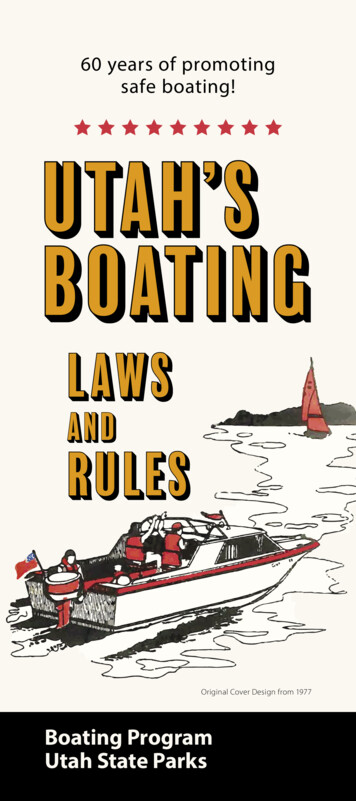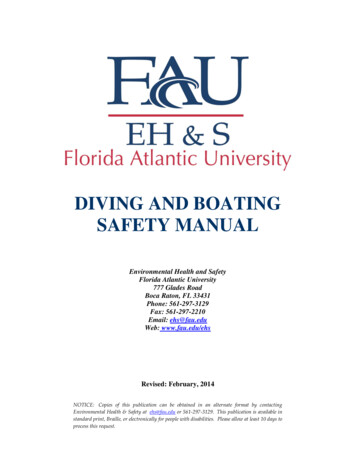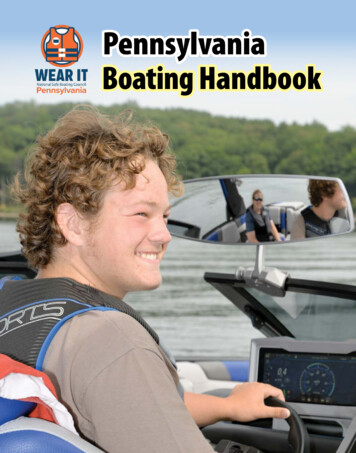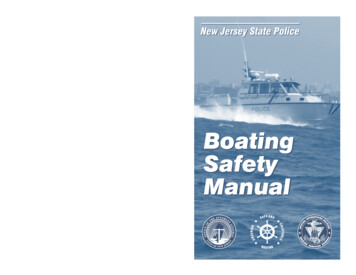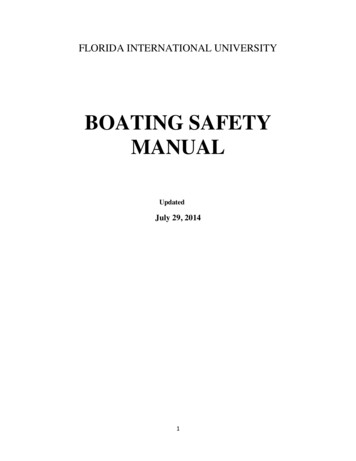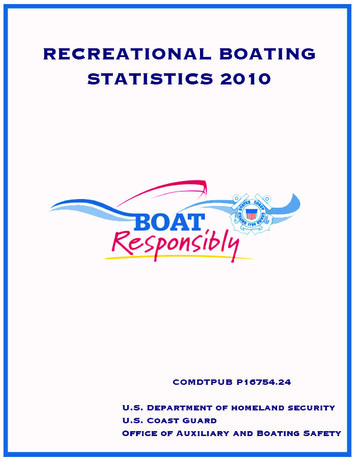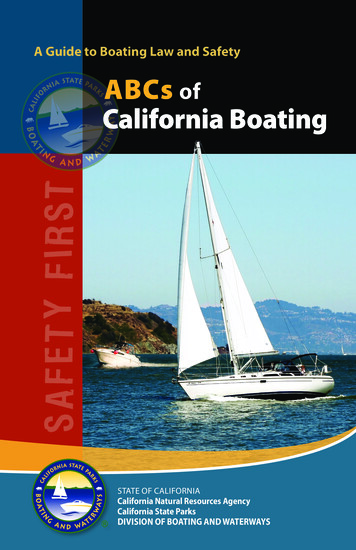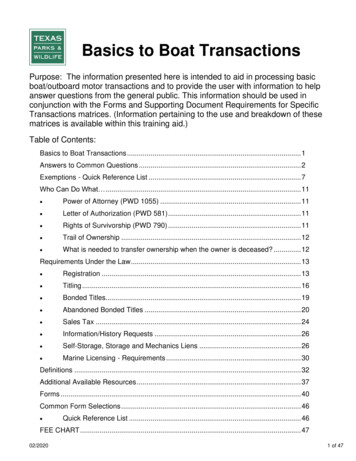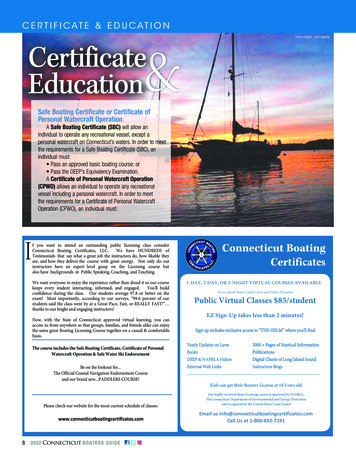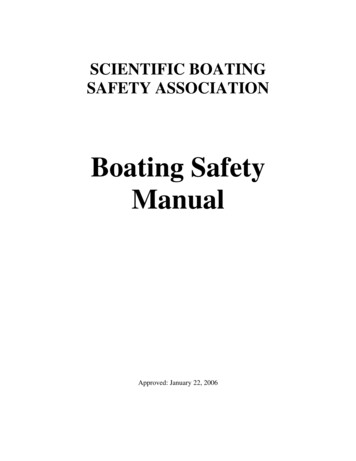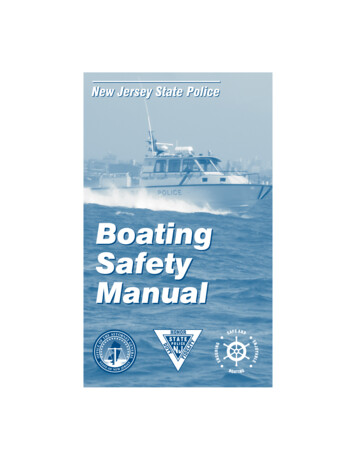
Transcription
New Jersey State PoliceBoatingSafetyManualFIDETYDULITYHONORSBALNA
LIGHTS REQUIRED ON BOATS BETWEEN SUNSET ANDSUNRISE AND AT ALL TIMES OF RESTRICTED VISIBILITYFigure 1Figure 2Figure 3orAorBBorInlandOnlyAB*Cell phones can also be very useful, however, other boatersin the area will not be able to hear your call for help. Keep inmind that you will lose reception quickly when on the water.Call 911 or one of the Marine Law Enforcement stations fromthe phone list on page 46.Figure 6Great LakesONLYorBoaters seeking information or emergency assistance,contact:New Jersey State PoliceMarine Law Enforcement(Closest station to your position)Call ChannelChannel 16, VHF Marine Band, Emergency ChannelAFigure 5Figure 4MARINE RADIO INFORMATIONorBorAABABBOATING SAFETY EDUCATIONAL PROGRAMThe New Jersey State Police Marine Services Bureauconducts safe boating programs annually. These programsare presented in schools during the winter months throughoutthe state. This program is free to those schools requesting thisservice.Figure 8For this and other presentation requests, contact:RANGE AND DEGREE OF VISIBILITY OF LIGHTSInland and InternationalLocationVisible RangeDegrees(In Nautical Miles)orMasthead light2/3225/225All-around light2/2360/360Side lights1/2112.5/112.5Stern light2/2135/135New Jersey State PoliceMarine Services BureauPO Box 7068West Trenton, NJ 08628-0068609-882-2000, ext. 617347
Table of ContentsNEW JERSEY SAFE BOATING . 1Boating Safety Education & Minimum Age Requirements.2Non-Tidal Boat License .4Navigation Rules.5CHAPTER 1Registration, Titling & Documentation . 7Boat Registration .7Registration Required .7Documented Vessels .8Numbering System & Display .9Validation Decal.10Obtaining Applications .10Change of Residence. 11Vessel Titling. 11CHAPTER 2Equipment . 12Muffling Device .12Coast Guard Approved Equipment .12Flame Arresters (Backfire Flame Control).12Sound Signaling Appliances For Vessels Less Than 20 Meters(65’6”).13Personal Flotation Devices .13Wearing of PFDs by Children 12 and Under .15Fire Extinguishers .16Marine Sanitation Devices (MSDs) .17Visual Distress Signals: The Regulations .18Visual Distress Signals: Handling and Storage.19Visual Distress Signals Types .20Visual Distress Warning.22Minimum Required Equipment by Length of Boat .22Meter-feet Conversions.24Rev. 02/06
CHAPTER 3Operator’s Responsibilities. 27Power-Driven Vessels .27International .27Inland .27Sailing Vessels & Vessels Under Oars .28International .28Inland .29Lights Used When Anchored .29International .29Inland .29Found Vessels.30Boating Accidents/Duties In Case of Accidents .30Speed.31Operating a Vessel Under the Influence of Intoxicating Liquor,Drugs or Narcotics .32Reckless or Careless Operation Forbidden .35Personal Watercraft .35Waterskiing .36Skin Diving .38Watercraft Noise Control .38Racing .39Race Test Permits.39Loading Your Boat .41Water Pollution and the Recreational Boater.41Discharge of Oil Prohibited .41CHAPTER 4For Your Protection. 42Security Afloat .42Report Stolen Boats and Equipment .44Bargain Deals.44Float Plan .44Marine Law Enforcement Stations .46Marine Radio Information .47Boating Safety Education Program.47Equipment Checklist. BACK COVER
NEW JERSEY SAFE BOATINGThe objective of the boating safety program is to reduce therisk of loss of life, injury and property damage associatedwith the use of recreational boats, and to provide the boaterswith the maximum safe use of the state’s waterways.The state recognizes the need for safe boating and highlyrecommends that the boating enthusiasts make themselvesthoroughly familiar with all of the laws, regulations andother information contained in this booklet. Boating is bestenjoyed when the boater is knowledgeable and diligent inobserving safety precautions. Rules and regulations quotedherein are most commonly used.New Jersey has adopted the Navigational Rules International-Inland and the Code of Federal Regulations as the standards for vessel equipment and operation. The NavigationalRules and the Code of Federal Regulations can be purchasedeither at a boat supply store or through a boating catalog. Inaddition to these standards, other laws, rules, and regulationshave been adopted for the waters of this State.Consult local authorities for information on local ordinances.1
BOATING SAFETY EDUCATION& MINIMUM AGE MANDATORY REQUIREMENTSAre you 16 years old orolder?NoYesHave you completedan approved BoatingSafety Course?NoYou cannot operateany power vessel onNew Jersey waters.Were you born in1979 or later?*YesYou may operate anypower vessel EXCEPT apersonal watercraft. Tooperate a personalwatercraft, you must havecompleted a boatingsafety course and have aboating safety certificate.NoYou must complete aboating safety courseprior to operating ANYpower vessel & have aboating safety certificate.*Schedule for Completion of Mandatory Boating Safety Course: Persons born in 1969 or later must possess a Boating Safety Certificateby June 1, 2006. Persons born in 1959 or later must possess a Boating Safety Certificateby June 1, 2007. Persons born in 1949 or later must possess a Boating Safety Certificateby June 1, 2008. All persons who wish to operate a power vessel must possess aBoating Safety Certificate by June 1, 2009.2
BOATING SAFETY EDUCATION& MINIMUM AGE MANDATORY REQUIREMENTSFor Those Under 16Are you 13 years old orolder?YesNoHave you completedan approved BoatingSafety Course?NoYesYou cannot operateany power vessel onNew Jersey waters.You may operate a vesselpowered solely by anelectric motor or a vessel12 feet long or longer withless than 10 HP.1) There are NO EXEMPTIONS to New Jersey age requirements.2) Out-of-state residents in New Jersey for less than 90days with a certificate issued by their state or country;OR written proof of completion of a substantially similarcourse to the NJ-approved course will satisfy the education requirements.Boating Safety Course information may be located at:www.cgaux.org www.usps.org www.BOATUS.comBoating Safety Courses must be completed in person.3
NON-TIDAL BOAT LICENSEAre you going to boat onnon-tidal water (Water wherethe tide does not change)?YesNoNo Non-Tidal BoatLicense required.Does one of the belowlisted exemptions apply?YesNoNon-tidal boatlicense required.Exemptions1) Vessel powered by a motor less than 1 HP or a 12 voltelectric motor.2) A vessel 12 feet long or longer with less than 10 HP.3) While competing in an authorized race pursuant to a permit issued by the Division of State Police in the Department of Law & Public Safety.4) If the person is an out-of-state resident who has written proof of successful completion of a course substantiallysimilar to a NJ approved Boating Safety Course.A boat license is separate from the boating safety certificateand is issued by the Motor Vehicle Commission (MVC).4
NAVIGATION RULESAll vessels operating on the waters of this State are responsible for adherence to the Navigation Rules International/Inland.The rules as defined in COMDTINST M16672.2D, are applied as set forth under the COLREGS Demarcation Lines.In addition, all vessels 12 meters (39’4”) and over in lengthare required to have on board a copy of the NavigationRules, International/Inland, COMDTINST M 16672.2D,while operating on the waters of this State.Rule 5, LOOKOUTEvery vessel shall at all times maintain a proper look-outby sight and hearing as well as by all available means appropriate in the prevailing circumstances and conditions soas to make a full appraisal of the situation and of the risk ofcollision.Rule 6, SAFE SPEEDEvery vessel shall at all times proceed at a safe speed so thatit can take proper and effective action to avoid collision andbe stopped within a distance appropriate to the prevailingcircumstances and conditions.Rule 7, COLLISIONEvery vessel shall use all available means appropriate to theprevailing circumstances and conditions to determine if riskof collision exists. If there is any doubt such risk shall bedeemed to exist.Rule 8, ACTION TO AVOID COLLISIONAny action taken to avoid collision shall, if the circumstances of the case admit, be positive, made in ample time and5
with due regard to the observance of good seamanship.If necessary to avoid collision or allow more time to assessthe situation, a vessel shall slacken its speed or take all wayoff by stopping or reversing its means of propulsion.Rule 9, NARROW CHANNELSA vessel proceeding along the course of a narrow channelor fairway shall keep as near to the outer limit of the channel or fairway which lies on its starboard side as is safe andpracticable.Rule 14, HEAD-ON SITUATIONWhen two power-driven vessels are meeting on reciprocalor nearly reciprocal courses so as to involve risk of collision,each shall alter its course to starboard so that each shall passon the port side of the other.Rule 15, CROSSING SITUATIONWhen two power-driven vessels are crossing so as to involve risk of collision, the vessel which has the other onits starboard side shall keep out of the way and shall, if thecircumstances of the case admit, avoid crossing ahead of theother vessel.Rule 16, ACTION BY GIVE-WAY VESSELEvery vessel which is directed to keep out of the way ofanother vessel shall, so far as possible, take early and substantial action to keep well clear.Rule 17, ACTION BY STAND-ON VESSELA power-driven vessel which takes action in a crossingsituation to avoid collision with another power-driven vesselshall, if the circumstances of the case admit, not alter courseto port for a vessel on its own port side.6
CHAPTER 1Registration, Titling & DocumentationBOAT REGISTRATIONAll titled boats must also be registered. In addition, any boatmechanically propelled, regardless of length, must be registered.If the boat is not titled, you will have to show proof of ownership. Any of the documents (see page 10) accepted fortitling are also acceptable for registration. You will also haveto give your New Jersey driver license number and SocialSecurity number.REGISTRATION REQUIREDEvery vessel in New Jersey waters shall be registered andnumbered, except:a. Vessels operated under a federally approved numbering system of another state, operated on a transientbasis;b. Documented vessels from other states operated inthis State in a transient status only;c. Vessels from foreign countries here temporarily;d. Public vessels of the United States, a state or subdivision or agency thereof;e. A ship’s lifeboat;f. Vessels used exclusively for racing while competingin an authorized race, or under permit issued fromthe New Jersey State Police;7
g. A non-powered sailboat or vessel used exclusivelyon small lakes and ponds wholly within privatelands;h. A non-powered inflatable, surfboard, racing shell ortender for direct transportation between a vessel andthe shore and for no other purpose (i.e. dinghy);i. Vessels 12 feet or less in lengthj. A non-powered kayak or canoe.DOCUMENTED VESSELS1. All documented vessels for which the owner maintains,owns, rents, leases or otherwise occupies space withinthis State, other than on a transient basis, MUST beregistered with this State according to the establishedfee schedule, but are not required to display numbers.Validation decals will be issued and must be displayedon these vessels.2. Registration certificates must be carried on board thevessel at all times while the vessel is in operation.3. Those vessels documented under Part 67 of Title 46,Code of Federal Regulations and required to registerwith this State pursuant to NJSA 12:7-34.44a shall display a validation sticker on each side of the vessel in anarea adjacent to the main steering station affixed to thevertical surface plainly visible at all times from both theport (left) and starboard (right) sides.8
NUMBERING SYSTEM & DISPLAY1. Boats will be numbered as follows;a. The registration numbers assigned shall consist ofthree (3) parts. The first part, known as the prefix,shall consist of the letters NJ, to indicate the state.The second part, known as the body, shall consistof not more than four (4) numbers. The third part,known as the suffix, shall consist of not more thantwo (2) letters.b. The parts shall be separated by a hyphen or an equivalent space equal to a number or letter.Examples: NJ-1234-ABNJ 1234 AB2. The identification number under the New Jersey numbering system shall be;a. Painted on or permanently attached to each side ofthe bow (the forward half) of the vessel, read left toright and in such position as to provide maximumvisibility.b. In block characters not less three (3) inches inheight.9
c. Of a color which will contrast with the color of thebackground (i.e. dark numbers on a light backgroundor light numbers on a dark background) and so maintained as to be visible and legible.3. No other numbers shall be carried on the bow of the vessel.VALIDATION DECAL1. The validation decal shall be placed on each side of thevessel, three (3) inches away from the registration number towards the back of the vessel.2. When the vessel is sold, it is the responsibility of theseller to remove the decals.3. Each registered vessel must display valid decals.4. Expired registration decals must not be visible.OBTAINING APPLICATIONSApplications for motorboat registration may be obtainedfrom marinas, boat dealers, Motor Vehicle Commissionagency, or by writing to:Motor Vehicle CommissionPO Box 017225 East State StreetTrenton, NJ 08666-0017Applications accompanied by correct fees, check or moneyorder, (NO CASH) may be mailed to above address. For theconvenience of the boating public, applications and fees maybe submitted at any Motor Vehicle Commission agency.10
CHANGE OF RESIDENCEWhenever the owner of a vessel registered and numberedwith the State of New Jersey changes their address from thatshown on their certificate of number, they shall, within seven(7) days, notify the Motor Vehicle Commission in writing oftheir new address. Record change forms are provided for thispurpose and will be mailed upon request. This record changeform may also be used to report a change(s) on a non-tidalboat license.VESSEL TITLINGIs the vessel longerthan 12 feet?NoYou do notneed a boattitle.YesIs it a brand newboat purchase?You will needmanufacturer'scertificate oforigin.YesNoWas it purchasedfrom a New Jerseyowner?YesNoDid last registeredstate require a title?YesComplete theassignmentsection on theback of the titleand have sellersign it.NoTake most recent vesselregistration along with a notarizedsigned statement attesting tothe accuracy of the H.I.N.In addition to the H.I.N., you willneed to know the year, make & typeof boat, its length, material usedfor construction, the source ofpower & the proposed use (pleasureor commercial). Take all of thisinformation, along with your driver'slicense # (or corpcode if companyowned) to your local M.V.C.11
CHAPTER 2EquipmentMUFFLING DEVICEEvery outboard motor, inboard motor or inboard/outboardmotor in use or attached to a vessel operating on the waters of this State shall be equipped with a muffling systemas supplied by the manufacturer or installed by the owner.The muffling system shall be maintained in good workingorder at all times. An exception to this requirement will beallowed for operation during authorized races sanctioned bythe United States Coast Guard, New Jersey State Police, orother operation with a race test permit issued by the StatePolice.COAST GUARD APPROVED EQUIPMENT“Coast Guard approved” is equipment which has been approved by the Commandant of the U.S. Coast Guard and hasbeen determined to be in compliance with U.S. Coast Guardspecifications and regulations relating to the materials, construction and performance of such equipment. New Jerseystate laws conform to these equipment requirements.FLAME ARRESTERS (Backfire Flame Control)Gasoline engines installed in a motorboat or motor vessel after April 25, 1940, except outboard motors, must have a U.S.Coast Guard approved flame arrester fitted to the carburetor.For exceptions see 46 CFR 25.35.12
SOUND SIGNALING APPLIANCES FOR VESSELSLESS THAN 20 METERS (65’6”)1. A vessel 12 meters (39’4”) or more in length but lessthan 20 meters (65’7”) shall be provided with a whistle.The whistle shall comply with the specifications listed inAnnex 3 of the Inland Navigational Rules Act of 1980.2. A vessel of less than 12 meters (39’4”) in length shall notbe obliged to carry the signaling appliance prescribedabove, but if it does not, it shall be provided with someother means of making an efficient sound signal.PERSONAL FLOTATION DEVICESNo person shall operate or allow any person to operate anyvessel in or on the waters of this State unless such vessel hasa United States Coast Guard approved wearable personalflotation device (PFD) of the correct size for each personon board. Such PFDs shall be of the type(s) and number(s)required by the United States Coast Guard for a vessel of theclass operating on Federal or state navigable waters. Thisincludes all vessels except surfboards, racing shells, rowingsculls and racing kayaks.TYPE IA Type I PFD has the greatest required buoyancy and is designed to turn most unconscious persons in the water froma face down position to a vertical or slightly backward position. The adult size device provides a minimum buoyancy of22 pounds and the child size provides a minimum buoyancyof 11 pounds. The Type I is most effective for all waters,especially offshore and ocean cruising, when there is probability of a delayed rescue.13
TYPE IIA Type II PFD is any approved wearable device designedto turn its wearer in a vertical or slightly backward positionin the water. The turning action is not as profound as with aType I, and the device will not turn as many persons underthe same conditions as the Type I. An adult size device provides a minimum buoyancy of 15 ½ pounds, the mediumchild size provides a minimum of 11 pounds, and the infantand small child sizes provide a minimum buoyancy of 7pounds.TYPE IIIA Type III PFD is any approved wearable device designedso the wearers can place themselves in a vertical or slightlybackward position. While the Type III has the same buoyancy as the Type II PFD, it has little or no turning ability. AType III PFD comes in a variety of style, colors and sizes.Many are designed to be particularly useful when waterskiing, sailing, hunting, fishing or engaging in other watersports. Several of this type will also provide increased hypothermia protection.TYPE IVA Type IV PFD is any approved device designed to bethrown to a person in the water and grasped and held untilrescued. It is not designed to be worn. The most commonType IV devices are a buoyant cushion and a ring buoy. Effective May 1, 1995 the Type IV PFD–a flotation device thatcan be thrown to a person in the water – can no longer beused as a substitute for a wearable flotation device. To meetthe PFD requirements for recreational vessels under 16 feetin length, wearable PFDs are required to be carried in thevessel. The requirements for vessels 16 feet and longer remain unchanged.14
TYPE VA Type V is any special purpose PFD such as a survival orexposure suit.TYPE V HYBRIDA Type V Hybrid PFD is an inflatable device that provides aminimum of 7 ½ pounds of buoyancy deflated and 22 poundsof buoyancy when inflated. In order for the device to be acceptable for use on recreational boats, it must be worn whenthe boat is underway and the user is above on deck. Wheninflated it turns the wearer similar to the action provided bya Type I, II or III PFD. A Type V Hybrid PFD must be wornin accordance with the information contained in the owner’smanuals supplied with each device.WEARING OF PFDS BY CHILDREN 12 AND UNDERIn addition to the previously listed requirements, any child12 years of age or younger must WEAR a properly fittedU.S. Coast Guard approved PFD whenever the vessel is underway. If the child is inside a fully enclosed cabin that is apermanent, non-removable part of the vessel that is designedto carry passengers, then the child is not required to wear thePFD.The 12 years of age or younger PFD law does not apply tothe following vessels:1. Vessels that are owned and operated by the United Statesor the State of New Jersey or an agency thereof; a countyor municipality; a volunteer first aid, rescue or emergency squad, a search and rescue unit established withina fire district created pursuant to or a volunteer fire company when a child is on board as a direct result of beingrescued from an emergency situation.15
2. Commercial vessels (any vessel longer than 65 feet operated for a purpose that requires a U.S. Coast GuardOperator’s or Master’s License).3. Ferries (any vessel longer than 65 feet operating on ashort run on a frequent schedule between two points offering a public service of a type normally attributed to abridge or tunnel).All PFDs that are presently acceptable on recreational boatsfall into one of these designations. All PFDs shall be U.S.Coast Guard approved, in good and serviceable conditionand of an appropriate size for the persons who intend to wearthem. Wearable PFDs shall be readily accessible and throwable devices shall be immediately available for use.FIRE EXTINGUISHERSEach fire extinguisher is classified by a letter and a romannumeral according to the type of fire it may be expected toextinguish and the size of the extinguisher. The “letter” indicates the TYPE OF FIRE the extinguisher can put out.A- Fires of ordinary combustible materials.B- Gasoline, oil and grease fire.C- Electrical fires.Extinguishers approved for motorboats are hand-portable, ofeither B-I or B-II -II5B6B1¼2½4152102½10Fire extinguishers must be carried on ALL motorboats thathave one or more of the following conditions which makethe boat of closed construction:16
1. Inboard engines,2. Closed compartments under thwarts and seats whereportable fuel tanks may be stored,3. Double bottoms not sealed to the hull or which are notcompletely filled with flotation materials,4. Closed living spaces,5. Closed stowage compartments in which combustible orflammable material is stowed, or6. Permanently installed fuel tanks.Dry chemical fire extinguishers without gauges or indicatingdevices must be weighed and tagged every 6 months. If thegross weight of a carbon dioxide (CO2) fire extinguisher isreduced by more than 10% of the net weight, the extinguisher is not acceptable and must be recharged.Check extinguishers regularly to be sure that gauges are freeand nozzle is clear.NOTE: READ LABELS ON FIRE EXTINGUISHERS. IFTHE EXTINGUISHER IS U.L. LISTED, IT IS APPROVEDFOR MARINE USE.MARINE SANITATION DEVICES (MSDs)A Marine Sanitation Device (MSD) must be certified as“type approved” or meet one of the exceptions provided byregulation.Boats 65 feet in length and under may use a Type I, II or IIIMSD. Boats over 65 feet are limited to installing Type IIor III MSDs. Coast Guard certified devices are also labeledwith the exception of holding tanks which are automaticallycertified under the regulations if they store only sewage andflush water at ambient air pressure and temperature.17
TYPE I MSD- Flow through; effluent USCG certified to1000 fecal coliform/ 100 ml, no visible floating solids standards.TYPE II MSD- Flow through; effluent USCG certified to200 fecal coliform /100 ml, 150 mg/1 total suspended solidsstandard.TYPE III MSD- USCG certified to no-discharge standard.All MSDs tested and certified by the Coast Guard will carrya label with the name of the manufacturer and the certification number. To obtain information about marine pumpoutstations call 1-800-ASK-FISH.VISUAL DISTRESS SIGNALS: THE REGULATIONSThe requirement to carry visual distress signals became effective on January 1, 1981. This regulation requires all recreational boats when used on coastal waters, which includesthe Great Lakes, the territorial seas and those waters directlyconnected to the Great Lakes and the territorial seas, up toa point where the waters are less than two miles wide, andboats owned in the United States when operating on the highseas to be equipped with visual distress signals.The only exceptions are during daytime (sunrise to sunset)for:1. Recreational boats less than 16 feet in length.2. Boats participating in organized events such as races,regattas or marine parades.3. Open sailboats not equipped with propulsion machineryand less than 26 feet in length.4. Manually propelled boats.These boats only need to carry night signals when used onthese waters at night.18
“PYROTECHNIC VISUAL DISTRESS SIGNALINGDEVICES” must be Coast Guard approved, in serviceablecondition, unexpired and readily accessible. Launchers,produced before January 1, 1981, intended for use withapproved signals are not required to be Coast Guard Approved.USCG approved pyrotechnic Visual Distress Signals and associated devices include:1. Pyrotechnic red flares, hand held or aerial.2. Pyrotechnic orange smoke, hand held or floating.3. Launchers for aerial red meteors or parachute flares.“NON-PYROTECHNIC VISUAL DISTRESS SIGNALING DEVICES” must carry the manufacturer’s certificationthat they meet Coast Guard requirements. They must be inserviceable condition and stowed to be readily accessible.This group includes:1. Orange distress flag.2. Electric distress light.No single signaling device is ideal under all conditions andfor all purposes. Consideration should be given to carryingseveral types. For example, an aerial flare can be seen overa long distance on a clear night, but for closer work, a handheld flare may be more useful.VISUAL DISTRESS SIGNALS:HANDLING AND STORAGEPyrotechnic devices should be stored in a cool, dry locationand must be readily accessible in case of an emergency. Careshould be taken to prevent puncturing or otherwise damaging their coverings. A watertight container, such as a surplus19
ammunition box, painted red or orange and prominentlymarked “DISTRESS SIGNALS” is recommended.If young children are frequently aboard your boat, carefulselection and proper stowage of visual distress signals isimportant.Coast Guard approved pyrotechnic devices carry an expiration date. After this date, the device can no longer be countedtoward the minimum requirements.VISUAL DISTRESS SIGNALS TYPESA visual distress signal is any device designed to showthat your vessel is in distress and help
2 BOATING SAFETY EDUCATION & MINIMUM AGE MANDATORY REQUIREMENTS *Schedule for Completion of Mandatory Boating Safety Course: Persons born in 1969 or later must possess a Boating Safety Certi fi cate by June 1, 2006. Persons born in 1959 or later must possess a Boating Safety Certi fi cate by June 1, 2007. Persons born in 1949 or later must possess a Boating Safety Certi fi cate
